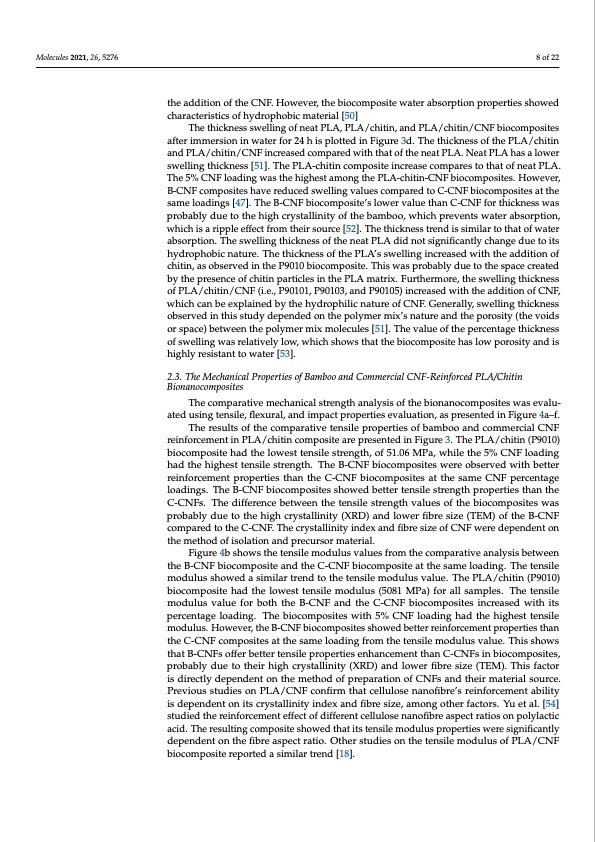
PDF Publication Title:
Text from PDF Page: 008
Molecules 2021, 26, 5276 8 of 22 the addition of the CNF. However, the biocomposite water absorption properties showed characteristics of hydrophobic material [50] The thickness swelling of neat PLA, PLA/chitin, and PLA/chitin/CNF biocomposites after immersion in water for 24 h is plotted in Figure 3d. The thickness of the PLA/chitin and PLA/chitin/CNF increased compared with that of the neat PLA. Neat PLA has a lower swelling thickness [51]. The PLA-chitin composite increase compares to that of neat PLA. The 5% CNF loading was the highest among the PLA-chitin-CNF biocomposites. However, B-CNF composites have reduced swelling values compared to C-CNF biocomposites at the same loadings [47]. The B-CNF biocomposite’s lower value than C-CNF for thickness was probably due to the high crystallinity of the bamboo, which prevents water absorption, which is a ripple effect from their source [52]. The thickness trend is similar to that of water absorption. The swelling thickness of the neat PLA did not significantly change due to its hydrophobic nature. The thickness of the PLA’s swelling increased with the addition of chitin, as observed in the P9010 biocomposite. This was probably due to the space created by the presence of chitin particles in the PLA matrix. Furthermore, the swelling thickness of PLA/chitin/CNF (i.e., P90101, P90103, and P90105) increased with the addition of CNF, which can be explained by the hydrophilic nature of CNF. Generally, swelling thickness observed in this study depended on the polymer mix’s nature and the porosity (the voids or space) between the polymer mix molecules [51]. The value of the percentage thickness of swelling was relatively low, which shows that the biocomposite has low porosity and is highly resistant to water [53]. 2.3. The Mechanical Properties of Bamboo and Commercial CNF-Reinforced PLA/Chitin Bionanocomposites The comparative mechanical strength analysis of the bionanocomposites was evalu- ated using tensile, flexural, and impact properties evaluation, as presented in Figure 4a–f. The results of the comparative tensile properties of bamboo and commercial CNF reinforcement in PLA/chitin composite are presented in Figure 3. The PLA/chitin (P9010) biocomposite had the lowest tensile strength, of 51.06 MPa, while the 5% CNF loading had the highest tensile strength. The B-CNF biocomposites were observed with better reinforcement properties than the C-CNF biocomposites at the same CNF percentage loadings. The B-CNF biocomposites showed better tensile strength properties than the C-CNFs. The difference between the tensile strength values of the biocomposites was probably due to the high crystallinity (XRD) and lower fibre size (TEM) of the B-CNF compared to the C-CNF. The crystallinity index and fibre size of CNF were dependent on the method of isolation and precursor material. Figure 4b shows the tensile modulus values from the comparative analysis between the B-CNF biocomposite and the C-CNF biocomposite at the same loading. The tensile modulus showed a similar trend to the tensile modulus value. The PLA/chitin (P9010) biocomposite had the lowest tensile modulus (5081 MPa) for all samples. The tensile modulus value for both the B-CNF and the C-CNF biocomposites increased with its percentage loading. The biocomposites with 5% CNF loading had the highest tensile modulus. However, the B-CNF biocomposites showed better reinforcement properties than the C-CNF composites at the same loading from the tensile modulus value. This shows that B-CNFs offer better tensile properties enhancement than C-CNFs in biocomposites, probably due to their high crystallinity (XRD) and lower fibre size (TEM). This factor is directly dependent on the method of preparation of CNFs and their material source. Previous studies on PLA/CNF confirm that cellulose nanofibre’s reinforcement ability is dependent on its crystallinity index and fibre size, among other factors. Yu et al. [54] studied the reinforcement effect of different cellulose nanofibre aspect ratios on polylactic acid. The resulting composite showed that its tensile modulus properties were significantly dependent on the fibre aspect ratio. Other studies on the tensile modulus of PLA/CNF biocomposite reported a similar trend [18].PDF Image | Supercritical Carbon Dioxide Isolation of Cellulose Nanofibre

PDF Search Title:
Supercritical Carbon Dioxide Isolation of Cellulose NanofibreOriginal File Name Searched:
molecules-26-05276-v2.pdfDIY PDF Search: Google It | Yahoo | Bing
Sulfur Deposition on Carbon Nanofibers using Supercritical CO2 Sulfur Deposition on Carbon Nanofibers using Supercritical CO2. Gamma sulfur also known as mother of pearl sulfur and nacreous sulfur... More Info
CO2 Organic Rankine Cycle Experimenter Platform The supercritical CO2 phase change system is both a heat pump and organic rankine cycle which can be used for those purposes and as a supercritical extractor for advanced subcritical and supercritical extraction technology. Uses include producing nanoparticles, precious metal CO2 extraction, lithium battery recycling, and other applications... More Info
| CONTACT TEL: 608-238-6001 Email: greg@infinityturbine.com | RSS | AMP |